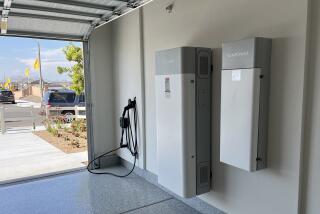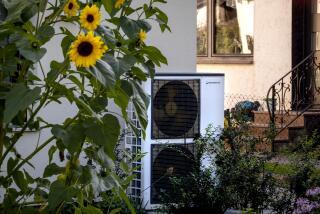Tankless water heaters don’t always reduce energy bills

STEVE BROWNELL has a dim view of his tankless water heater, and he’s in denial about his utility bills.
Three years ago, the Irvine resident installed the heater in his 3,000-square-foot, single-story home with the goal that the unit would pay for itself fairly quickly through lower gas bills and provide an endless supply of hot water.
“At the time, I was thinking it would be a total utility savings -- gas, water and electric,” Brownell said.
Think again. Instant energy savings aren’t necessarily guaranteed. Although manufacturers estimate that tankless gas-type water heaters can save between 20% to 50% on annual gas bills compared with standard tanks, improper installation or product sizing can extend the payoff time. Also, large homes with long pipe runs may require additional equipment to speed up hot water delivery to fixtures and actually drive up energy costs. This was the case in Brownell’s situation.
He paid a plumber about $2,500 for the installation, which included increasing the size of his gas line, adding a carbon filter and the tankless water heater itself.
Soon after, he noticed it was taking an extremely long time for the unit to deliver hot water to his master bath shower. By Brownell’s estimates, almost five minutes. He had another plumber install a recirculation pump to reduce the time, but he said it didn’t help much.
After he placed several phone calls and sent a letter, the manufacturer dispatched Gabe Meier of Santa Ana-based Meier Plumbing to troubleshoot the problem.
The reason it was taking so long for Brownell to get hot water to his shower, Meier said, was that the lines in the master bathroom branch 10 to 15 feet off the main water supply line, which stretches more than 75 feet from the water heater. To fix it would require opening up a wall and extending the circulating line closer to the shower -- an extra $1,000, according to Meier. Because Brownell’s master bathroom contains high-end custom stone and glass block, he elected not to have the work completed.
Even so, Meier was able to troubleshoot other areas and improve the hot water delivery.
“The recirculation pump was too small for the size of the home, and it didn’t have an aquastat,” Meier said, referring to a thermostat that turns off the pump when the water in the pipe reaches a certain temperature. “So we upgraded the pump and added the aquastat.”
Meier also added a timer to shut the pump off for a preset number of hours and cut down on electricity usage.
Although all the extra work has helped reduce the time it takes to get his hot water, Brownell said his dream of lower utility bills has become a recurring nightmare. “I’m not saving anything,” he said. “In fact, I’m paying more for all three utilities.”
Most tankless installations do not incur these types of problems, Meier said, but because Brownell’s house is 3,000 square feet and the pipe runs are long, the recirculation pump was necessary. “When you estimate a tankless water installation, you won’t know the exact distance of the pipe runs from a main water line to the master shower, for example, without doing some extra research.”
With that in mind, before having a tankless water heater installed, here are some questions that manufacturers recommend consumers consider:
* Is your plumbing contractor licensed in California and certified by the manufacturer to install the product? Most tankless water heater manufacturers provide a list of plumbing contractors authorized to service and install the units on company websites.
* Has your contractor sized the tankless water heater properly so it can serve the correct number of fixtures in your home?
* Will you need a Category III stainless vent pipe, or will the unit be installed on the home’s exterior?
* Will you need to increase the size of your gas line? Tankless water heaters typically require a 3/4 -inch gas line.
* Depending on your community’s water quality, will you need a water softener or another type of filtration device to protect the tankless unit from hard-water deposit buildup?
* Will you need a recirculation pump (or comparable system) to reduce the amount of time it takes to deliver hot water to your faucets and fixtures?
To encourage tankless water heater sales, Southern California Gas Co. implemented a $200 rebate program last year. For the first five months of the program, the utility recorded only 560 rebates. But as more manufacturers get on board, the number of tankless water heaters being installed in Southern California appears to be brisk.
“Our records indicate that 3,897 units have been installed so far in 2008 in our service territory” based on rebates, said Denise King, public relations manager for Sempra Energy, parent company of Southern California Gas Co.
The rebate program, which is scheduled to end Dec. 31, does not track customer satisfaction. Consumer Reports, however, will be reporting on tankless water heaters in October.
More to Read
Sign up for our L.A. Times Plants newsletter
At the start of each month, get a roundup of upcoming plant-related activities and events in Southern California, along with links to tips and articles you may have missed.
You may occasionally receive promotional content from the Los Angeles Times.






